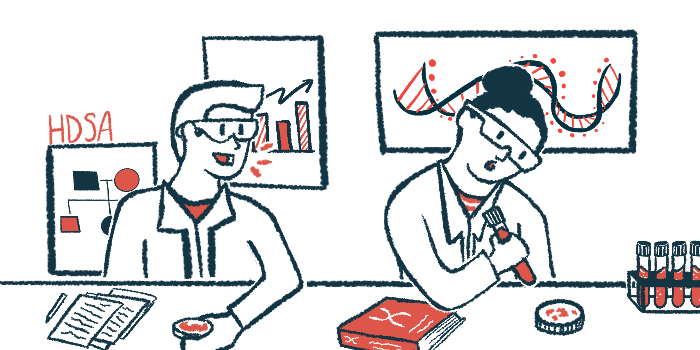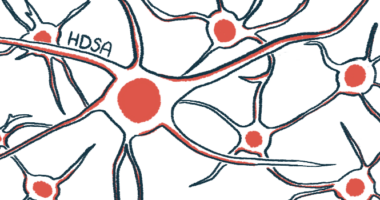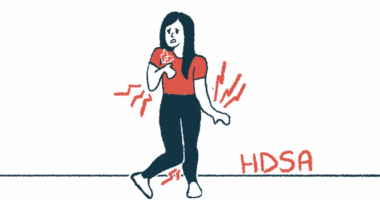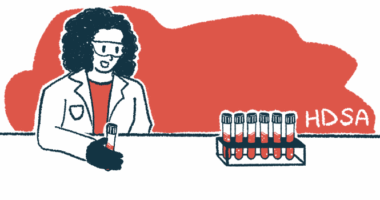HDSA 2025: Speakers spotlight Huntington’s clinical trials
Treatments aim to lower levels of disease-driving protein huntingtin

Several treatments aiming to reduce levels of mutant huntingtin (mHTT), the protein that drives Huntington’s disease, are being tested in clinical trials or may soon enter clinical testing.
Company representatives described those therapies in a luncheon session at the 40th annual Huntington’s Disease Society of America (HDSA) convention, held June 26-28 in Indianapolis.
Huntington’s is caused by mutations in the HTT gene that lead to the production of mHTT, which forms toxic clumps that are thought to drive Huntington’s-associated neurodegeneration.
Roche is developing three therapies aiming to ultimately lower mHTT levels. Tominersen, the most advanced candidate, is designed to reduce production of both mutant and healthy (wild-type) huntingtin protein. It was tested in the Phase 3 GENERATION HD1 trial (NCT03761849), which was discontinued in 2021 after interim analyses indicated the therapy was not benefiting patients.
Further analyses, however, hinted at potential benefits for those with early Huntington’s given the therapy’s low dose. Roche subsequently launched a Phase 2 trial, called GENERATION HD2 (NCT05686551), to test two low tominersen doses against a placebo in people with early-stage Huntington’s.
Trial in ‘final lap’
The main goals of GENERATION HD 2, which is fully enrolled, include assessing tominersen’s safety and its effects on measures of disease progression after more than a year of treatment.
A recent analysis of interim data identified no safety concerns and indicated that the 100 mg dose seemed more likely to provide benefit, so the trial has been modified to test tominersen only at that dose.
“We are incredibly grateful to the 301 participants and their companions enrolled in GENERATION HD 2 around the world,” Rita Gandhy, MD, senior medical director of Huntington’s clinical development at Genentech, a Roche subsidiary, told the HDSA audience. “Each study visit contributes to collecting data that helps understanding about tominersen … [and] we are now in the final lap and we can say that data are expected next year.”
Roche is also developing a gene therapy called RG6662 (formerly SPK-10001). Like tominersen, it aims to reduce levels of all huntingtin forms, but while tominersen is given through regular injections into the spinal canal, RG6662 is administered directly into the brain via a one-time surgical procedure.
By delivering “genetic instructions to stop the production of huntingtin protein … directly to the parts of the brain that are most affected in [Huntington’s],” Gandhy said, “the hope is that a long-lasting benefit can be achieved with this one-time procedure.”
A Phase 1/2 trial (NCT06826612) is testing RG6662 in adults with Huntington’s, ages 25-65. Recruitment is ongoing at two centers in Ohio, and the first participant was dosed about a month ago.
“We will wait several months before dosing the next people [with higher doses] to ensure safety checks are met [and] will build the program over time,” Gandhy said.
After determining RG6662’s optimal, safest dose, the study is planned to move to its next phase, in which additional participants will be randomly assigned to receive either RG6662 or a placebo and will be followed for up to five years.
Roche’s third candidate, in preclinical stages, aims to reduce mHTT by targeting a naturally occurring genetic variation that is frequently found in the mutated HTT gene copy.
An observational study (NCT06667414) is assessing how common the specific variant is among adults ages 25-60 with a Huntington’s-causing mutation. Recruitment is ongoing at more than 30 sites worldwide.
“If enough people carry the [genetic variation], and if the lab findings continue to hold, we hope to launch a Phase 1 study in the future,” Gandhy said.
Wave candidate looks to selectively lower mutant protein
Wave Life Sciences’ experimental treatment WVE-003 uses a similar approach. It targets a genetic variation called SNP3 that is often found in the mutated HTT copy.
“The key point in our approach is that we are looking to selectively lower the mutant huntingtin protein while preserving and not touching the wild-type protein as much as possible,” Jane Atkins, PhD, Wave’s senior vice president of portfolio strategy and program management, said. The wild-type protein is important for nerve cell health, she noted.
WVE-003, administered into the spinal canal, was tested in the Phase 1b/2a SELECT-HD trial (NCT05032196), which involved 60 Huntington’s patients.
Results showed that three injections of WVE-003 (30 mg), each separated by eight weeks, safely and effectively reduced mHTT levels in the fluid around the brain and spinal cord by 46% relative to a placebo, while preserving wild-type huntingtin.
“That’s exactly what we wanted to see,” Atkins said.
This reduction was associated with less shrinkage (atrophy) in the caudate nucleus, a brain region that’s characteristically damaged in Huntington’s.
“What this means is that the more [mHTT lowering] you have … you’re losing less of the caudate,” Atkins told the HDSA group, adding that this finding “is really encouraging but … very preliminary.”
Wave is planning a Phase 2/3 trial to test WVE-003, given every 12 weeks instead of every eight weeks as in SELECT-HD, in up to 150 people with early Huntington’s, Atkins said.
The company expects to file later this year for regulatory clearance to launch the study. Should results be positive, they will be used to support applications seeking the therapy’s approval.
uniQure eyes one-time gene therapy
Similar to Roche’s RG6662, uniQure’s AMT-130 is a one-time gene therapy administered into the brain via a surgical procedure. It’s designed to reduce levels of both mutant and wild-type huntingtin.
AMT-130 is being tested in a pair of Phase 1/2 trials, one in the U.S. (NCT04120493) and one in Europe (NCT05243017).
“We hope the data will show that it can delay, possibly prevent, progression of the symptoms of [Huntington’s], providing long-term benefit from that single treatment and helping patients maintain a quality of life,” said David Margolin, MD, PhD, uniQure’s vice president of clinical development.
Data so far have been promising in terms of AMT-130’s effect on Huntington’s progression. The gene therapy carries “serious risks, but so far it appears that it’s generally well tolerated and that we believe the risks are manageable,” Margolin said.
uniQure plans to ask the U.S. Food and Drug Administration to grant accelerated approval to AMT-130. Accelerated approval allows a treatment to be brought to market based on biomarker data from clinical trials supporting its efficacy. Full approval requires further trial data to confirm the therapy’s benefits.
“It is an exciting time, not only for our program and the prospects of a potential regulatory review and approval, but from the other companies that you’ve heard about … today,” Margolin told the HDSA audience. “There’s really a hope, I believe, for effective treatments.”
Margolin stressed that these advancements are only possible because people in the Huntington’s community have been willing to step up and participate in clinical research.
“We wouldn’t be where we are today without the involvement and contributions of the patient community,” he said. “For that, we thank you.”
Note: The Huntington’s Disease News team is providing virtual coverage of the Huntington’s Disease Society of America annual convention June 26-28. Go here to see the latest stories from the conference.









